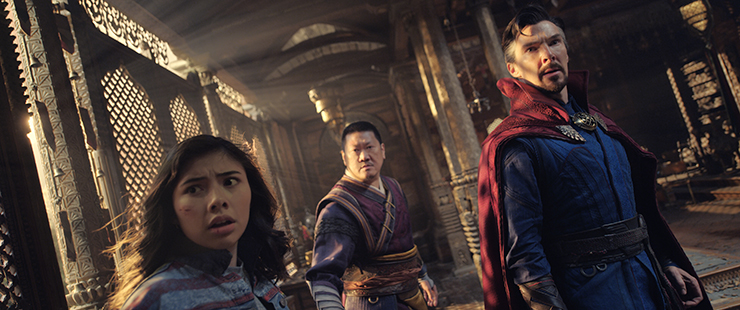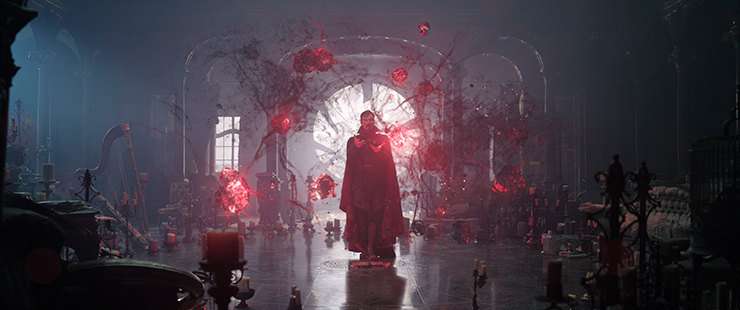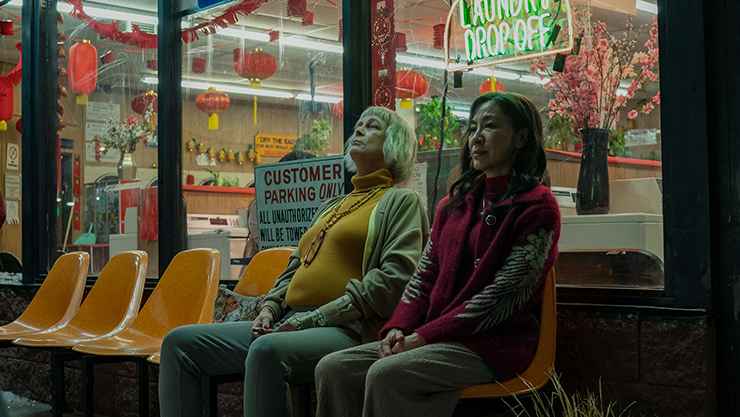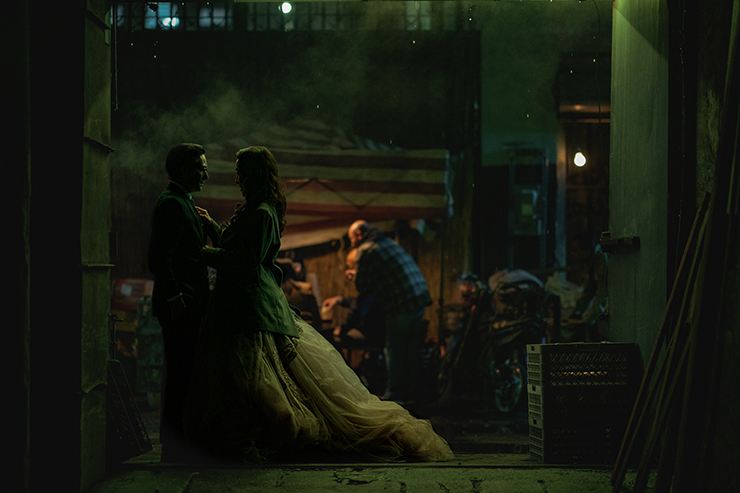
Xochitl Gomez, Benedict Wong and Benedict Cumberbatch in a scene from "Doctor Strange in the Multiverse of Madness." (Photo courtesy of Marvel Studios)
What if? It's a question we often ask ourselves, usually when things don't go as planned or we're confronted with a crushing setback. Disney Plus turned the very concept into serialized catnip for the Marvel Cinematic Universe hive mind. But that show is only a drop in the bucket in a popular, constantly evolving trend that has captured media consumers' imagination in recent years.
The multiverse and alternate realities are concepts that have caught fire, and how could they not? Take the multiverse and its irresistible premise: what if there are myriad versions of you out there? Better versions of you who have succeeded, who struck while the iron was hot where you let a golden opportunity pass by. For example, I'm certain Other Me's have been delivering nonstop reviews for your reading pleasure with dependable precision in the year 2022. (This World Me promises to do better as we head into the summer months.)
Two movies, now playing in theaters, plunge viewers headlong into the multiverse with rewarding results. They may share some formal and thematic similarities, and their target audiences may intersect, but they're ultimately different animals. They're flip sides of a coin that values creativity and sneaks in unexpected, occasionally subversive content into the mix. You almost hear the filmmakers whispering in your ear those three little words we need to hear every now and then: just let go.
“Doctor Strange in the Multiverse of Madness”: Sam Raimi is trolling you. Sure, the bad boy behind the “Evil Dead” trilogy and “Drag Me to Hell” lulls you into a sense of complacency, appearing to acclimate to the MCU's one-size-fits-all approach to world building and tentpole interconnectedness. He waits until you're convinced this long-awaited sequel to the first “Doctor Strange” will unfold like business as usual, with a Defense Against the Dark Arts twist thrown in for good measure.

Benedict Cumberbatch in a scene from "Doctor Strange in the Multiverse of Madness." (Photo courtesy of Marvel Studios)
Then he opens Pandora's box and unleashes those creepy creatures his fans have come to know and love. Cue the irreverent, cheerfully grotesque mayhem. Raimi may now be an elder statesman of comic book adaptations (and a mixed bag of thrillers, dramas and even a Western), but he's still up to his old tricks, with a computer-generated upgrade. You might want to grab onto something.
When we last saw Dr. Stephen Strange (Benedict Cumberbatch, one of the MCU's MVPs), the surgeon-turned-sorcerer was helping to clean up the mess Peter Parker made when he Sorcerer's Apprenticed his way into bringing baddies from prior Spider-Man franchises into the universe that Marvel Studios president Kevin Feige shepherded into global domination. I braced for the inevitable onslaught of MCU callouts.
The fact that the events of last December's “Spider-Man: No Way Home” are mentioned but not obsessively dwelled upon serves as your first tip-off that we're not in Kansas anymore, Dorothy. I wouldn't dream of spoiling the way Raimi throws viewers off the deep end as “Multiverse of Madness” opens. Suffice it to say, Strange is perturbed by visions that are not of this universe, and the timing couldn't be worse. He's about to do what a supportive ex does when a relationship ends on amicable terms: put up a strong front and attend her wedding.
The ensuing scene, showing Dr. Christine Palmer (the radiant Rachel McAdams) walking down the aisle, almost makes “Multiverse of Madness” feel like a romantic comedy, albeit one with a bittersweet twinge. Strange, you see, still nurses feelings for the good doctor, and he blames himself for the way things ended between them. The touching moment serves as a reminder that, in between his iconic horror films and more understated “grown-up” fare, Raimi made the Tobey Maguire/Kirsten Dunst-fronted “Spider-Man” trilogy of the 2000s.
Those movies never lost sight of the relationships stitching together the genre trappings, a balancing act the MCU has struggled to maintain. “Sit back, sonny, and let an old pro show you how it's done,” Raimi appears to say here. It becomes clear, at least to those of us exhausted by the MCU's emphasis on uniformity, that we're in capable hands.

LEFT: Elizabeth Olsen in a scene from "Doctor Strange in the Multiverse of Madness." Photo courtesy of Marvel Studios. RIGHT: Rachel McAdams, Benedict Cumberbatch and Xochitl Gomez in a scene from "Doctor Strange in the Multiverse of Madness." (Photos courtesy of Marvel Studios)
Raimi takes elements from other MCU tentpoles and turns them on their head, starting with Wanda Maximoff (Elizabeth Olsen). “Multiverse of Madness” does assume you've seen “WandaVision” on Disney Plus, but gives viewers unfamiliar with last year's miniseries a Cliffs Notes summary: Wanda, better known as the Scarlet Witch, took an entire town hostage so she could live out her white picket fence fantasy alongside Vision (Paul Bettany), a red-hued android introduced in “Avengers: Age of Ultron” under circumstances too convoluted to go into here.
When beings from another universe seep their way into ours, Strange seeks Wanda's counsel, only to be confronted with a grim reality. The misunderstood antihero who did some naughty things before using her considerable mind-control abilities to help save the world is no longer batting for the good guys' team. It's a startling realization that risks alienating Wanda fans, but Raimi doesn't care about your feelings. You can already sense the filmmaker working scenarios in his head using the character as a wraithlike force of destruction. Think Sissy Spacek in “Carrie.” Yes, there are some surprise cameos in here, but they're. um, used differently than in other Marvel flicks.
The visual possibilities are endless, and as “Multiverse” morphs into something akin to a feature-length scavenger hunt across the multiverse, the typically flat MCU visuals give way to more inventive, eye-popping imagery. Raimi uses his trademark curlicues to mold the Marvel formula into something that begins to resemble his “Evil Dead” movies without completely surrendering to those films' delirious anarchy.
There's a danger that “Multiverse of Madness” might be too weird for diehard MCU devotees and not edgy enough for longtime Raimi fans, and while this production has had a bumpy behind-the-scenes history, the way Raimi juggles these aesthetic balls in the air mostly feels just right.
If there's anything holding “Multiverse of Madness” back from being a total home run, it's the way it tends to sideline America Chavez (Xochitl Gomez), the new addition to the “Doctor Strange” family, and stick her with plot device duties. A budding do-gooder with the (currently uncontrollable) power to travel across universes, she's ostensibly a leap forward in LGBTQ+ representation from the MCU, but other than establishing she has two mothers, the movie stops short of exploring her own queer identity.
Director Chloé Zhao made further strides when helming her own MCU adventure, last fall's uneven but unfairly maligned “Eternals.”

LEFT: Stephanie Hsu, Michelle Yeoh, Ke Huy Quan in a scene from "Everything Everywhere All at Once." RIGHT: Stephanie Hsu, Ke Huy Quan, Michelle Yeoh and James Hong in a scene from "Everything Everywhere All at Once." (Photos by Allyson Riggs)
What does come across loud and clear, as America and Strange join forces to help bring balance to the multiverse, is that both characters are weighed down by their guilt, and the paternal instinct she brings out in Strange is unexpectedly moving. It helps anchor an occasionally unmoored thrill ride that's the most fun this critic has had with the MCU since the first “Avengers” back in 2012. Instead of restraining a filmmaker to stick to the status quo, “Multiverse of Madness” allows Raimi to let his freak flag fly to a significant degree. He delivers the goods. Now was that so hard, Mr. Feige?
“Everything Everywhere All at Once”: What if the fate of the multiverse was not up to a superhero but the Chinese-American owner of a struggling laundromat with a marriage on the rocks and a strained relationship with her lesbian daughter? Sounds like the kind of Amerindie conceit that's doomed to yield precious and twee results. But the latest inspired oddity from the directing duo of Daniel Kwan and Daniel Scheinert, better known as Daniels, is not your typical genre mishmash. It's a one-in-a-million swing for the fences, powered by enough unbridled creativity and depth of feeling to rekindle the most disillusioned cinephile's love affair with the movies.
Life is coming hard at Evelyn Wang (Michelle Yeoh). In addition to putting up with her husband Waymond (Ke Huy Quan) and his goofy disposition, sullen resentment from her daughter Joy (Stephanie Hsu) and lingering disapproval from her visiting dad (veteran character actor James Hong), she is scrambling to get her finances in order so she can make her meeting with IRS inspector Deirdre Beaubeirdra (a nearly unrecognizable Jamie Lee Curtis is a hoot). Audits are never fun, and this one in particular feels like it represents far more than the state of her business.
But what Evelyn is about to discover is that the IRS building she's about to step into will also serve as a portal of sorts, a jumping-off point for a mind-expanding and trippy journey into other worlds and other selves. She's about to see some bizarre things, stranger than anything in the “Doctor Strange” movies, beginning with the fact that her husband's body becomes intermittently possessed by a Waymond from an universe. He's trying to ferret out a dark force intent on letting chaos reign, and Evelyn finds out, to her initial skepticism and encroaching dread, that she might just have a crucial role to play in this fight.

Jamie Lee Curtis and Michelle Yeoh in a scene from "Everything Everywhere All at Once." (Photos by Allyson Riggs)
Did I say fight? Brace yourself, because once the Daniels take us down their rabbit hole, “Everything Everywhere” unleashes kung fu mayhem that sees, for instance, a fanny pack turned into a fearsome weapon. Interspersed with the chop-socky rumbles, the filmmakers saddle Quan with a ton of exposition in an attempt to ensure viewers keep up.
We understand enough, but it will probably take multiple viewings to grasp all the nuances of the abilities Evelyn finds herself trying out, mostly out of necessity. If it sounds like information overload, you won't get an argument from me. (A second viewing unearthed more of a method to the madness.) The difference between what the Daniels (“Swiss Army Man”) are attempting here and, say, a convoluted puzzle like Christopher Nolan's “Tenet” is that “Everything Everywhere” is oodles of fun, whereas Nolan treats his spatial inversions with sacrosanct seriousness.
But here's the neatest hat trick the Daniels pull off. Underneath the sci-fi, martial arts and surprisingly bawdy gags, they never lose sight that their film is, at heart, a tender portrait of a dysfunctional family, and the way they're able to sustain this tonal high-wire act is nothing short of masterful. Think of Ang Lee's “Father Knows Best” trilogy from the 1990s, then throw “The Matrix” and a kajillion other movie references into the Osterizer.
Everyone on the other side of the camera is bringing their “A” game, on a reported $25 million budget, no less. Costume designer Shirley Kurata's wardrobe embraces the mundane, the outlandish and everything in between. Son Lux's score captures the film's off-kilter vibe and its more earthbound parts, and editor Paul Rogers makes sure all of these disparate elements hang together and are reasonably easy to follow.
It would all come apart at the seams, however, were it not for the iconic Yeoh, who tears into her juicy role with abandon. It's a hell of a star turn. Quan, who became an instantly recognizable part of the mid-1980s movie landscape by playing Short Round in “Indiana Jones and the Temple of Doom” and Data in “The Goonies,” emerges as a fine actor who matches Yeoh step by step, most movingly in an alternate universe that sees them as exes reuniting like a scene from a Wong Kar-wai movie. (Memo to A24, the studio releasing “Everything Everywhere”: Quan delivers a lead performance, not supporting, so don't even think about resorting to category fraud.)

Ke Huy Quan and Michelle Yeoh in a scene from "Everything Everywhere All at Once." (Photo by Allyson Riggs)
The film's secret weapon is Hsu, who has the film's trickiest role. She shows that the ruptured bond between a mother and daughter is a mountain to climb, not a crisis to resolve, for both parties. If some of Hsu and Yeoh's scenes together have you reaching for the Kleenex, these are tears everyone involved with this gloriously absurd, soul-tingling movie have earned.
Here's what's truly bold about “Everything Everywhere All at Once”: it doesn't try to be all things to all people. It's a keeper, in any universe.
“Doctor Strange in the Multiverse of Madness” is now showing in wide release across South Florida, including IMAX engagements at AMC Aventura, AMC Sunset Place, Regal South Beach, CMX Dolphin Mall and the AutoNation IMAX at the Museum of Discovery and Science in downtown Fort Lauderdale. “Everything Everywhere All at Once” is also showing in wide release, but in not as many theaters.




